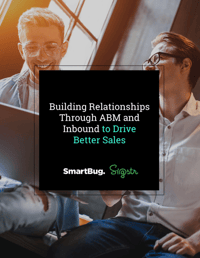
Incorporate Account-Based Marketing into Your Entire Campaign
January 16, 2019
By Sam McCue
Increasing amounts of noise have led businesses to take a more targeted, account-based approach to their sales marketing strategies. In case you’re unfamiliar, account-based marketing (ABM) is the practice of expanding your brand recognition among different personas in a single company across a list of named accounts. ABM has seen a spike in popularity among B2B companies in the last three years. In fact, according to the Information Technology Services Marketing Association, 84 percent of companies say that ABM delivers higher ROI than other types of marketing. With an overwhelming number of testimonials that ABM does, in fact, work—there are a few steps you can take to make sure that your ABM strategy spans the entire length of your campaign.
Sales
Account-based marketing expands the traditional sales coverage model. It used to be that cold-calling as many CEOs and VPs as possible was the quickest way to start and close a cycle. This can still be true today, but due to decreasing accessibility to these individuals, sales reps are spending more time calling into multiple levels of the account. By and large, this is the reason why cold-calling is being replaced by more productive activities in the “best practices lineup.”
Your sales team should be contacting leads in all levels of an organization that have previously been nurtured and exposed to your messaging by marketing activities. This is essentially like prying open a door by putting a wedge at the base, the top, and the middle to get the most leverage. After enough wedges have been added, the slightest tap of your hammer (your sales team) can burst that door wide open.
For example, let's say you identify 40 named accounts and then tell your team “I want to acquire revenue from these companies this year.” From there, your sales team spends its time gathering information on who the decision makers, champions, and influencers are within these accounts. This process is a mixture of paid and inbound marketing, and good old-fashioned research. Then they can set up a sequence to make sure that each of the individuals within each account gets touched the appropriate amount of times.
According to TOPO, it takes 18 calls on average to connect with a buyer. Do the math—18 calls to each member you’ve identified across 40 accounts. With numbers like these, it’s never been more critical to align your ABM strategy across sales and marketing.
Paid
The simplest way to target is the old “pay-to-play” model. Various ad platforms, such as LinkedIn, have made it simple to target the exact accounts, roles, and industries based on whatever criteria you need. Keeping a pulse on paid initiatives is key, because you want to make sure you’re continually maximizing your ROI.
For example, if your sales team is ready to target 25 financial firms, they'll be calling everyone from the firms’ customer service reps to their VPs. Make sure that before they get someone on the phone, the person they’re calling has seen an advertisement or organic post for a persona-relevant piece of content on LinkedIn. For your sales team, this can mean the difference between a hang-up and an initial conversation.

Inbound
Because inbound is heavily centered on attracting high-quality leads from out in the internet-wilderness, it might seem a bit off to incorporate that into an ABM strategy where you already know who your leads are. This is not the case. Remember that providing value is the cornerstone of any marketing strategy—or else you come off too “salesy.” The leads you are pursuing in your ABM strategy will be educating themselves before they speak to sales, and your content is the perfect opportunity for them to do that. Creating content and conversion opportunities that are in line with the various buyer personas will allow you to build your brand recognition within those accounts by giving them something they’re already looking for. Inbound can also be a great way to find named accounts to add to your strategy.
For example, if you’re selling sales enablement software and targeting real estate companies, you might want to create an infographic that would attract buyer's agents, and then create an e-book that would resonate with the realtors in those accounts. Before long, your solution will be brought up in efficiency conversations as a relevant solution they “stumbled upon.”
HubSpot Academy "Prof Tip"
"ABM adds wings to normal inbound techniques. Instead of creating web pages and offers that cast as wide a net as possible, you can create personalized content for specific target accounts. This removes a lot of limitations and creates a lot of space for creative ideas."
- Kyle Jepson, Senior Inbound Sales Professor
If you align these key elements and take a scientific approach to measuring ROI, you will begin to notice the benefits of a holistic strategy. As with everything, patience is key. If you put in the work building a sound strategy on the front end, you’ll spend less time putting out fires and fixing disconnects over the life of your ABM strategy.

About the author
Sam McCue was formerly an Inbound Marketing Specialist at SmartBug, and has a comprehensive background in branding, sales acceleration, and sales engagement. From large organizations to small startups, Sam's main focus is aligning progress with business goals. Sam is a lifelong fly fisherman and lives in Hayden, ID with his wife Amanda, and blue heeler Sadie. Read more articles by Sam McCue.






